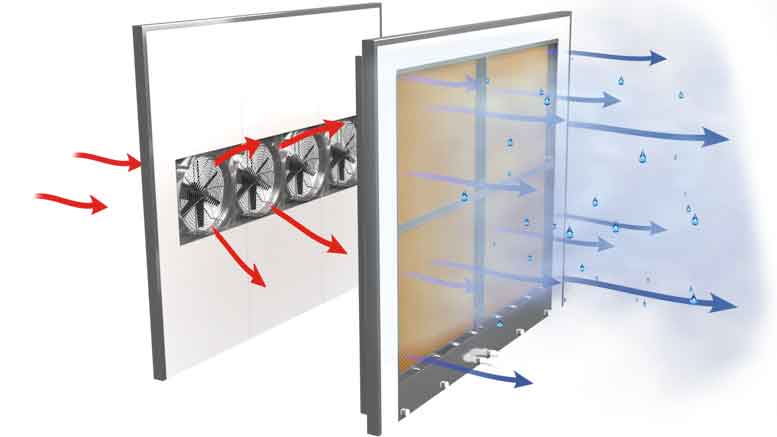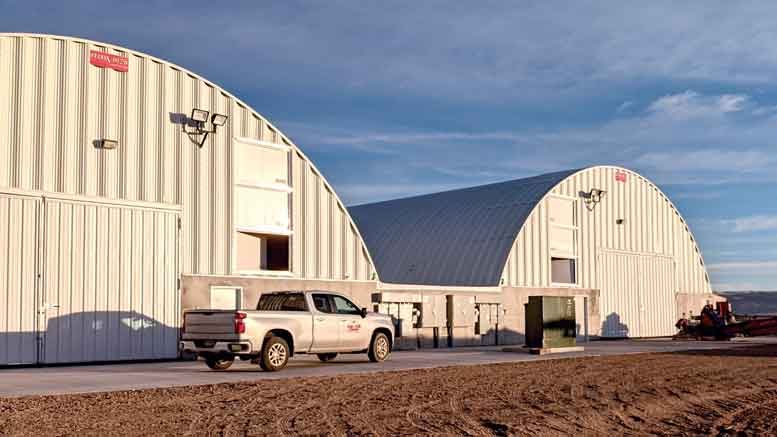|
Click to listen to this article
|
By John Klimes, Product Quality Specialist, Agri-Stor
During the coldest parts of the year when high temperatures are around 20 degrees, we start to see problems with condensation over tubers in storage. This is caused by air with high humidity being pushed through the potatoes and out the top where it meets a cold surface. This cold surface causes condensation to collect.
What to Do
A quick fix is to place heaters on top of the pile to warm the air, giving it the ability to hold more moisture. Also, check the thickness and quality of the insulation.
A second fix, which is more complex to understand, would be to “let the potatoes be the heater.” Slow your fan speed to allow your potatoes to heat the air 1 to 1.2 degrees as it moves through the pile. This is the delta T – the difference in temperature between the top and bottom of the pile – we are looking for.
For example, if the set point is 48, we would want the pulp temperatures on the bottom of the pile to be 48. When the air comes out the top, we want it to be between 49 and 49.2, and the potato pulp temperature on the top would also be 49 to 49.2. One degree increase in temperature has an enormous water holding capacity and will effectively reduce the humidity.
What Not to Do
Do not increase fan speed or turn off the ClimaCell. If you increase the fan speed, your delta T will tighten so the temperature at the bottom of the pile and at the top will be the same. This means that the humidity being pushed in the bottom of the pile will be equal to the humidity coming out the top. With a fraction of a degree in cooling, condensation will appear over your pile.
If you turned your ClimaCell off, turn it back on. The cell is an evaporative cooling device that maintains high humidity through evaporation. This evaporation cools the air and will maintain humidity above 95 percent. If the air enters the cell at 98 percent humidity, no additional humidity will be added. It just passes through. If you bring in fresh air that is drier, say 85 percent, water will evaporate into the air, increasing the humidity. This evaporation also causes cooling.

If your cell is turned off and fresh air enters your plenum, say 85 percent humidity, then it will find water to evaporate somewhere – the floor or the potato. Potatoes are very high in water content and the skin (in the best case) will only resist evaporation down to about 90 percent humidity. So, here’s what happens. You shut the cell off and now the air is working to increase humidity by evaporating it off of the floor and from the tubers. Because potatoes are big bags of water, the air will pull moisture out of the tubers to increase the humidity in the air so that when the air comes out the top of the pile, it will be 95 to 98 percent humidity. This will condense on your ceiling just as bad as it did before.
And it gets worse. Remember that when water evaporates, it cools. The set point was 48 and the plenum temperature is 48. Check the pulp temperatures. You will likely find that after about three days, your bottom pulp temperatures will decrease noticeably by up to a full degree, depending on the amount of evaporation. How can this be when your plenum is 48? This is due to the evaporation of the water from the tuber, also known as shrink.
Furthermore, as the air moves through the pile, evaporating water, it will continue to cool. As air cools, the water holding capacity is decreased. At some point, the air will cool to the dew point and moisture will condense out of the air, leaving water behind. Check the pulp temperatures on the bottom and top of your pile. If the temperatures at the bottom of your pile are warmer than the temperatures at the top of your pile, you have an inverted delta T. This is all caused by the cooling effect of evaporation of water from tubers that should have taken place in the cell.
A Real Problem
If the temperatures drop and the dew point is reached within the pile, there will be a very wet band of moisture in your pile instead of on your ceiling. Free water in the pile is not a good thing. Adding more is worse.
If you want to dry out areas or the ceiling, allowing temperature to increase as it flows through your pile is your best bet. As air warms, its moisture holding capacity increases. A delta T of 1 to 1.2 degrees will help dramatically. Higher delta T will begin to dry out the pile. To protect product quality, we can monitor what is happening in the pile by watching the carbon dioxide (CO2) levels. If CO2 exceeds 2,000 ppm, air speed should be increased.

